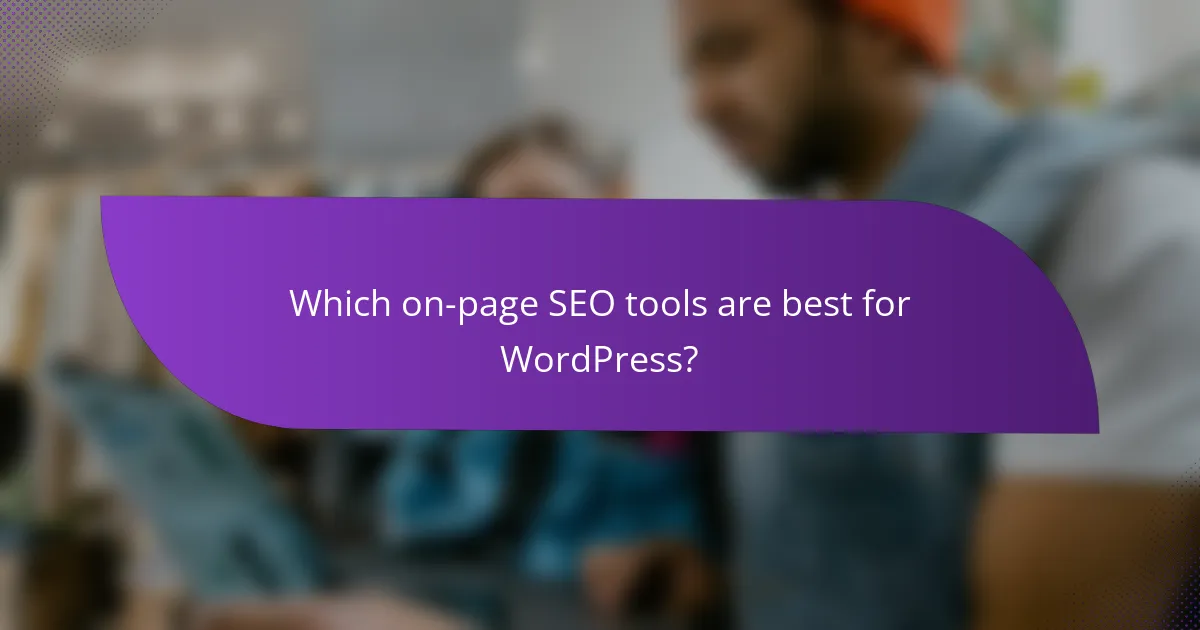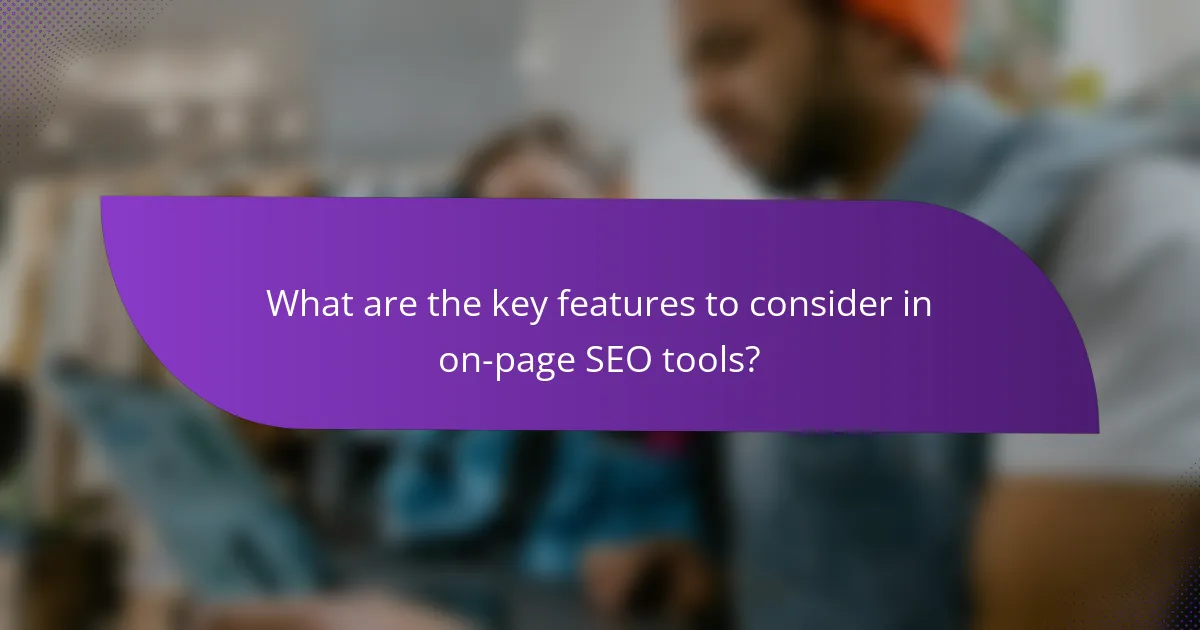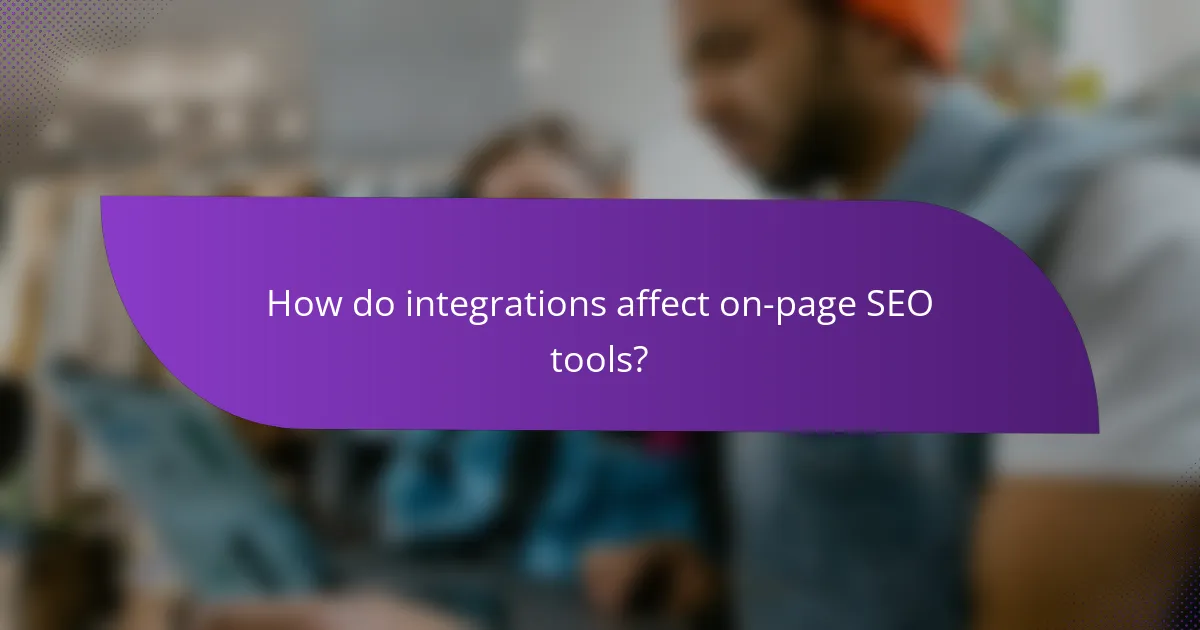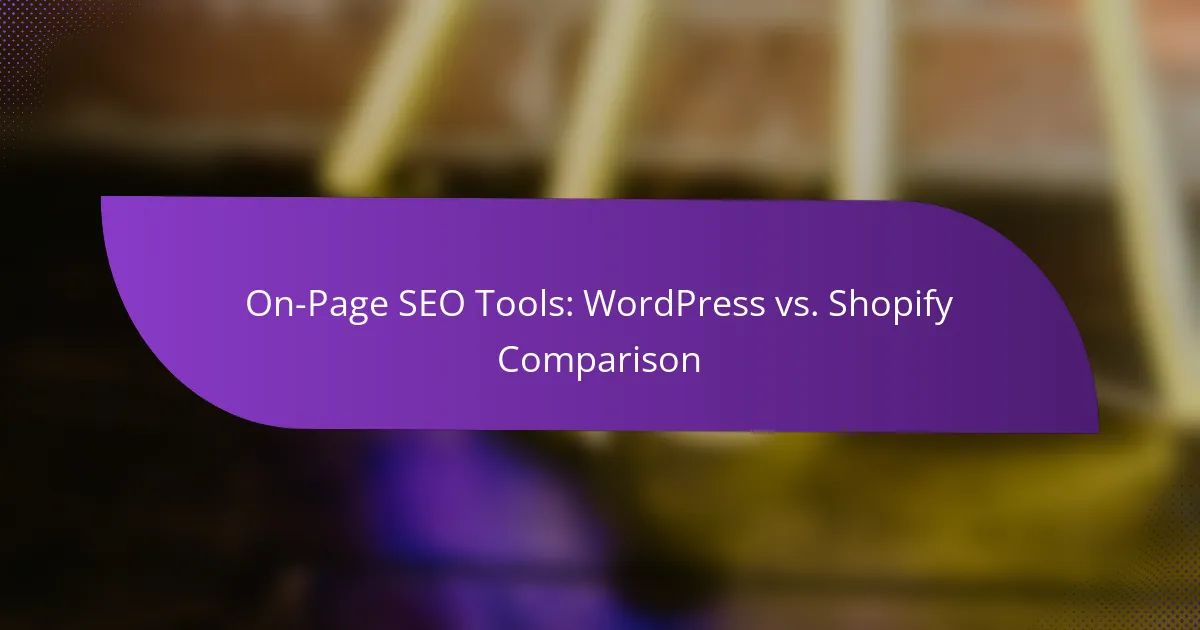When it comes to on-page SEO, both WordPress and Shopify present distinct advantages tailored to different user needs. WordPress offers a range of powerful plugins like Yoast SEO and Rank Math, allowing for extensive customization and optimization. In contrast, Shopify provides a more streamlined approach with tools designed to enhance store visibility and improve search engine rankings efficiently. Understanding these differences can help users choose the right platform for their SEO strategy.

Which on-page SEO tools are best for WordPress?
The best on-page SEO tools for WordPress include plugins that enhance your site’s visibility and optimize content effectively. Key options like Yoast SEO, Rank Math, and SEMrush offer various features tailored to improve search engine rankings.
Yoast SEO
Yoast SEO is one of the most popular plugins for WordPress, providing a comprehensive suite of tools to optimize your content. It features real-time content analysis, readability checks, and keyword optimization suggestions, making it user-friendly for beginners and experienced users alike.
When using Yoast, focus on its traffic light system to gauge your content’s SEO quality. Aim for a green light on both SEO and readability scores to maximize your chances of ranking well. Regularly update the plugin to access the latest features and improvements.
Rank Math
Rank Math is a powerful SEO plugin that offers advanced features often found in premium tools, but at no cost. It includes options for schema markup, local SEO, and integration with Google Search Console, making it a versatile choice for optimizing your WordPress site.
Consider using Rank Math’s setup wizard to configure settings based on your specific needs. Its modular approach allows you to enable only the features you require, keeping your site lightweight. Regularly monitor your SEO performance through its built-in analytics.
SEMrush
SEMrush is a comprehensive SEO tool that, while not a WordPress plugin, integrates seamlessly with WordPress sites to provide in-depth analysis and keyword tracking. It offers features like site audits, competitor analysis, and backlink tracking, which are crucial for a robust SEO strategy.
Utilize SEMrush’s keyword research tool to identify high-potential keywords relevant to your niche. Regularly perform site audits to identify and fix SEO issues, ensuring your WordPress site remains optimized for search engines. Consider its pricing plans, which vary based on the features you need.

Which on-page SEO tools are best for Shopify?
Shopify offers several effective on-page SEO tools that can enhance your store’s visibility and search engine rankings. The best tools focus on optimizing content, improving site speed, and ensuring proper indexing by search engines.
Plug in SEO
Plug in SEO is a user-friendly tool designed to help Shopify users identify and fix on-page SEO issues. It scans your site for common problems like missing meta tags, broken links, and slow loading times, providing actionable recommendations to improve your SEO performance.
This tool offers a free version with basic features, while the paid version unlocks more advanced functionalities. Users should regularly check their SEO status to stay ahead of potential issues and maintain optimal site performance.
SEO Manager
SEO Manager is a comprehensive tool that allows Shopify store owners to manage their on-page SEO effectively. It offers features such as customizable title tags, meta descriptions, and URL redirects, making it easier to optimize individual pages for search engines.
One key advantage of SEO Manager is its user-friendly interface, which simplifies the optimization process even for those with limited technical knowledge. Regularly updating your SEO settings with this tool can lead to improved visibility and higher click-through rates.
Smart SEO
Smart SEO automates many aspects of on-page SEO, making it a great choice for busy Shopify merchants. This tool generates meta tags, alt tags for images, and structured data automatically, saving time while ensuring your site is optimized for search engines.
Additionally, Smart SEO provides insights into your site’s performance and suggests improvements. Users should take advantage of its automation features but also periodically review the generated content to ensure it aligns with their branding and marketing goals.

How do WordPress and Shopify compare for on-page SEO?
WordPress and Shopify both offer unique advantages for on-page SEO, catering to different user needs. WordPress excels in customization and flexibility, while Shopify provides a more streamlined, user-friendly experience for e-commerce.
Customization capabilities
WordPress is renowned for its extensive customization options, allowing users to modify nearly every aspect of their site. With thousands of plugins and themes available, you can tailor your on-page SEO strategies to fit specific needs, such as optimizing meta tags, headings, and image alt texts.
In contrast, Shopify offers limited customization, primarily focusing on e-commerce functionalities. While it provides built-in SEO features like customizable title tags and meta descriptions, users may find it challenging to implement advanced SEO techniques without third-party apps.
Ease of use
Shopify is designed for ease of use, making it ideal for beginners who want to set up an online store quickly. Its intuitive interface allows users to manage on-page SEO elements without extensive technical knowledge.
WordPress, while powerful, has a steeper learning curve. Users need to familiarize themselves with its dashboard and various plugins to effectively manage on-page SEO. However, this complexity can lead to greater control over SEO strategies once mastered.
Cost-effectiveness
When considering cost-effectiveness, WordPress can be more budget-friendly, especially for those who can handle hosting and maintenance themselves. Basic hosting plans can start as low as a few dollars a month, and many SEO plugins are free or low-cost.
Shopify, on the other hand, has a monthly subscription model that can add up, particularly for larger stores. While it includes hosting and security, the monthly fees can range from around $30 to over $300, depending on the plan, which may impact overall cost-effectiveness for some users.

What are the key features to consider in on-page SEO tools?
When evaluating on-page SEO tools, focus on features that enhance visibility, user experience, and content relevance. Key aspects include keyword optimization, content analysis, and site speed enhancement, which collectively contribute to better search engine rankings and user engagement.
Keyword optimization
Keyword optimization is essential for ensuring your content ranks well in search results. Tools should help identify relevant keywords, assess their search volume, and analyze competition. Look for features that suggest long-tail keywords, synonyms, and related terms to broaden your reach.
For effective keyword optimization, consider using tools that offer real-time suggestions as you write. This can help you seamlessly integrate keywords into your content without compromising readability. Aim for a keyword density of around 1-2% to maintain a natural flow.
Content analysis
Content analysis tools evaluate the quality and relevance of your text, helping to ensure it meets user intent. These tools typically check for readability, keyword usage, and overall structure, providing insights on how to improve your content’s effectiveness.
Utilize content analysis features that offer scoring systems based on SEO best practices. For example, a tool might assess your content against top-ranking pages for similar keywords, highlighting areas for improvement. Regularly updating and optimizing existing content can significantly boost your SEO performance.
Site speed enhancement
Site speed is a critical factor for both user experience and SEO rankings. On-page SEO tools should provide insights into loading times and suggest optimizations, such as image compression and script minification, to improve performance.
To enhance site speed, aim for loading times under three seconds. Tools that offer performance audits can help identify bottlenecks and recommend specific actions. Regularly monitoring your site speed can prevent potential drops in rankings and user engagement.

What are the pricing models for on-page SEO tools?
On-page SEO tools typically follow various pricing models, including monthly subscriptions, one-time fees, and free trials. Understanding these models can help you choose the right tool based on your budget and needs.
Monthly subscriptions
Monthly subscriptions are a common pricing model for on-page SEO tools, allowing users to pay a recurring fee for access. Prices can range from around $10 to several hundred dollars per month, depending on the features offered. This model often includes regular updates and customer support.
When selecting a subscription, consider the features you need, such as keyword tracking, site audits, or content optimization tools. Be aware that some tools may offer tiered pricing based on the number of websites or users.
One-time fees
One-time fees are another option for on-page SEO tools, where you pay a single amount for lifetime access. These fees can vary widely, typically ranging from $50 to over $500, depending on the complexity and capabilities of the tool. This model is appealing for those who prefer not to commit to ongoing payments.
However, one-time purchases may not include ongoing updates or support, so it’s crucial to check the terms before buying. Consider whether the tool meets your long-term needs, as SEO practices evolve over time.
Free trials
Many on-page SEO tools offer free trials, allowing potential users to test the software before committing financially. These trials usually last from a week to a month and provide access to most features. This is an excellent way to evaluate the tool’s effectiveness for your specific requirements.
During a free trial, take the opportunity to explore all functionalities, assess user experience, and determine if the tool aligns with your SEO strategy. Be mindful of cancellation policies to avoid unexpected charges once the trial ends.

How do integrations affect on-page SEO tools?
Integrations play a crucial role in enhancing on-page SEO tools by allowing seamless connectivity with various applications and services. This connectivity can streamline processes, improve data analysis, and enhance overall site performance, which are vital for effective SEO strategies.
Third-party app compatibility
Third-party app compatibility significantly influences the effectiveness of on-page SEO tools. Both WordPress and Shopify offer a range of plugins and apps that can enhance SEO capabilities, but their compatibility varies. For instance, WordPress has thousands of plugins specifically designed for SEO, while Shopify has a more limited selection, focusing on essential functionalities.
When choosing a platform, consider the specific SEO tools you need. WordPress users can access popular plugins like Yoast SEO or All in One SEO, which provide comprehensive features for optimizing content. In contrast, Shopify users might rely on apps like SEO Manager or Plug in SEO, which offer basic functionalities tailored to e-commerce.
Ensure that any third-party app you choose is regularly updated and well-reviewed. Compatibility issues can arise if an app is outdated or not maintained, potentially leading to SEO setbacks. Always check user feedback and support options before integrating new tools into your site.
